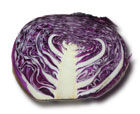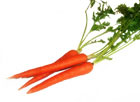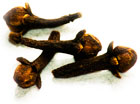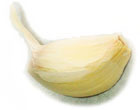Recipe
GOODNESS
 Cabbage:
This big head of leaves is from the ancient family of brassica that includes broccoli, Brussels sprouts, chard, kohlrabi and bok choy. When it is cooked a bit too long, these veggies will give off an odor of rotten eggs. That's due to the sulfur compounds that make them all so healthy, so you have to take the good with the bad. These handy chemicals are cancer fighters that work by pushing potential cancer-causing cells to commit suicide. In addition, they contain antioxidants and help prevent cardiovascular disease. They are also full of vitamins and minerals, so get some cabbage into your diet. The only warning is to people with hypothyroidism, who shouldn't overindulge. Cabbage:
This big head of leaves is from the ancient family of brassica that includes broccoli, Brussels sprouts, chard, kohlrabi and bok choy. When it is cooked a bit too long, these veggies will give off an odor of rotten eggs. That's due to the sulfur compounds that make them all so healthy, so you have to take the good with the bad. These handy chemicals are cancer fighters that work by pushing potential cancer-causing cells to commit suicide. In addition, they contain antioxidants and help prevent cardiovascular disease. They are also full of vitamins and minerals, so get some cabbage into your diet. The only warning is to people with hypothyroidism, who shouldn't overindulge. |
 Carrots:
We all know that carrots are good for your eyes, but did you know they have anti-cancer properties as well? They have the nicely named carotenoids that are antioxidents -- chemicals that mop up the damage that results from ordinary metabolism. That, in turn, helps to keep your cells from turning rogue and hanging with the cancer gangs. If that's not enough to make you grab a carrot, they turn out to be immune-system stimulators as well, meaning you'll have fewer occasions to ask "What's up, doc?" Yes there's a little sugar in them, but also a lot of fiber to buffer it, so only the most sugar-restricted people should worry. By the way, the vitamin K in carrots is easier to absorb if you eat them with a bit of oil or fat, like a dip. Carrots:
We all know that carrots are good for your eyes, but did you know they have anti-cancer properties as well? They have the nicely named carotenoids that are antioxidents -- chemicals that mop up the damage that results from ordinary metabolism. That, in turn, helps to keep your cells from turning rogue and hanging with the cancer gangs. If that's not enough to make you grab a carrot, they turn out to be immune-system stimulators as well, meaning you'll have fewer occasions to ask "What's up, doc?" Yes there's a little sugar in them, but also a lot of fiber to buffer it, so only the most sugar-restricted people should worry. By the way, the vitamin K in carrots is easier to absorb if you eat them with a bit of oil or fat, like a dip. |
 Cloves:
The dried buds of a tropical evergreen, cloves are a wonderful blast of fragrance and flavor.
They were the first known breath fresheners, but have a long, rich history in the spice trades.
These sweet but pungent buds can overwhelm a recipe, so beware!
Cloves:
The dried buds of a tropical evergreen, cloves are a wonderful blast of fragrance and flavor.
They were the first known breath fresheners, but have a long, rich history in the spice trades.
These sweet but pungent buds can overwhelm a recipe, so beware! |
 Garlic:
Garlic is in the same family as onions and leeks, and purportedly provided ancient Roman soldiers the courage to battle the barbarians.
Whether or not it gives you courage, it is known to lower blood pressure, which is great for your heart and helps prevent stroke.
In addition, it has a long history as a digestive aid, so don't be shy with this wonderful herb, no matter what it does to your breath!
Garlic:
Garlic is in the same family as onions and leeks, and purportedly provided ancient Roman soldiers the courage to battle the barbarians.
Whether or not it gives you courage, it is known to lower blood pressure, which is great for your heart and helps prevent stroke.
In addition, it has a long history as a digestive aid, so don't be shy with this wonderful herb, no matter what it does to your breath! |
ADVERTISEMENT
Help • Site Map • About Us • Contact Us • Privacy Policy • Press Center
Spice Plan™ Copyright © 2009 by Scott Charles Anderson. All rights reserved.